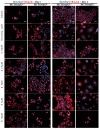Synthesis of 2,6-Diamino-Substituted Purine Derivatives and Evaluation of Cell Cycle Arrest in Breast and Colorectal Cancer Cells
- PMID: 30103421
- PMCID: PMC6222518
- DOI: 10.3390/molecules23081996
Synthesis of 2,6-Diamino-Substituted Purine Derivatives and Evaluation of Cell Cycle Arrest in Breast and Colorectal Cancer Cells
Abstract
Reversine is a potent antitumor 2,6-diamino-substituted purine acting as an Aurora kinases inhibitor and interfering with cancer cell cycle progression. In this study we describe three reversine-related molecules, designed by docking calculation, that present structural modifications in the diamino units at positions 2 and 6. We investigated the conformations of the most stable prototropic tautomers of one of these molecules, the N6-cyclohexyl-N6-methyl-N2-phenyl-7H-purine-2,6-diamine (3), by Density Functional Theory (DFT) calculation in the gas phase, water and chloroform, the last solvent considered to give insights into the detection of broad signals in NMR analysis. In all cases the HN(9) tautomer resulted more stable than the HN(7) form, but the most stable conformations changed in different solvents. Molecules 1⁻3 were evaluated on MCF-7 breast and HCT116 colorectal cancer cell lines showing that, while being less cytotoxic than reversine, they still caused cell cycle arrest in G2/M phase and polyploidy. Unlike reversine, which produced a pronounced cell cycle arrest in G2/M phase in all the cell lines used, similar concentrations of 1⁻3 were effective only in cells where p53 was deleted or down-regulated. Therefore, our findings support a potential selective role of these structurally simplified, reversine-related molecules in p53-defective cancer cells.
Keywords: cell cycle arrest; endoreduplication; microwave-assisted synthesis; molecular docking; p53; reversine.
Conflict of interest statement
The authors declare no conflict of interest.
Figures





Similar articles
-
Reversine induces cell cycle arrest, polyploidy, and apoptosis in human breast cancer cells.Breast Cancer. 2014 May;21(3):358-69. doi: 10.1007/s12282-012-0400-z. Epub 2012 Aug 28. Breast Cancer. 2014. PMID: 22926505
-
Reversine induces cell cycle arrest and apoptosis via upregulation of the Fas and DR5 signaling pathways in human colorectal cancer cells.Int J Oncol. 2019 May;54(5):1875-1883. doi: 10.3892/ijo.2019.4746. Epub 2019 Mar 13. Int J Oncol. 2019. PMID: 30864676
-
Regiospecific microwave-assisted synthesis and cytotoxic activity against human breast cancer cells of (RS)-6-substituted-7- or 9-(2,3-dihydro-5H-1,4-benzodioxepin-3-yl)-7H- or -9H-purines.Eur J Med Chem. 2008 Aug;43(8):1742-8. doi: 10.1016/j.ejmech.2007.10.025. Epub 2007 Oct 25. Eur J Med Chem. 2008. PMID: 18069093
-
Reversine: A Synthetic Purine with a Dual Activity as a Cell Dedifferentiating Agent and a Selective Anticancer Drug.Curr Med Chem. 2020;27(21):3448-3462. doi: 10.2174/0929867326666190103120725. Curr Med Chem. 2020. PMID: 30605049 Review.
-
Terpenyl-purines from the sea.Mar Drugs. 2009 Dec 23;7(4):833-49. doi: 10.3390/md7040833. Mar Drugs. 2009. PMID: 20098613 Free PMC article. Review.
Cited by
-
Identification of the zebrafish homologues of IMPG2, a retinal proteoglycan.Cell Tissue Res. 2023 Oct;394(1):93-105. doi: 10.1007/s00441-023-03808-z. Epub 2023 Jul 20. Cell Tissue Res. 2023. PMID: 37470839 Free PMC article.
-
Synthesis and Cytotoxic Activity of the Derivatives of N-(Purin-6-yl)aminopolymethylene Carboxylic Acids and Related Compounds.Molecules. 2023 Feb 15;28(4):1853. doi: 10.3390/molecules28041853. Molecules. 2023. PMID: 36838839 Free PMC article.
-
Role of Bcl-2 on drug resistance in breast cancer polyploidy-induced spindle poisons.Oncol Lett. 2020 Mar;19(3):1701-1710. doi: 10.3892/ol.2020.11256. Epub 2020 Jan 7. Oncol Lett. 2020. PMID: 32194662 Free PMC article.
-
Heterocycles in Medicinal Chemistry.Molecules. 2019 Oct 25;24(21):3839. doi: 10.3390/molecules24213839. Molecules. 2019. PMID: 31731387 Free PMC article.
-
Design, Synthesis and Cancer Cell Growth Inhibition Evaluation of New Aminoquinone Hybrid Molecules.Molecules. 2019 Jun 14;24(12):2224. doi: 10.3390/molecules24122224. Molecules. 2019. PMID: 31197105 Free PMC article.
References
-
- Anastasia L., Sampaolesi M., Papini N., Oleari D., Lamorte G., Tringali C., Monti E., Galli D., Tettamanti G., Cossu G., et al. Reversine-treated fibroblasts acquire myogenic competence in vitro and in regenerating skeletal muscle. Cell Death Differ. 2006;13:2042–2051. doi: 10.1038/sj.cdd.4401958. - DOI - PubMed
-
- Pikir B.S., Susilowati H., Hendrianto E., Abdulrantam F. Reversine increase the plasticity of bone marrow-derived mesenchymal stem cell for generation of cardiomyocyte in vitro. Acta Med. Indones. 2012;44:23–27. - PubMed
MeSH terms
Substances
LinkOut - more resources
Full Text Sources
Other Literature Sources
Research Materials
Miscellaneous

